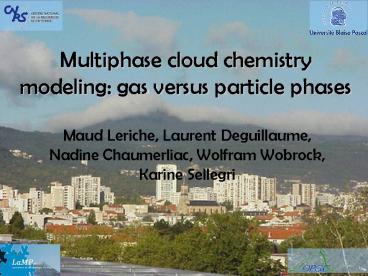Multiphase cloud chemistry modeling: gas versus particle phases PowerPoint PPT Presentation
1 / 11
Title: Multiphase cloud chemistry modeling: gas versus particle phases
1
Multiphase cloud chemistry modeling gas versus
particle phases
Maud Leriche, Laurent Deguillaume, Nadine
Chaumerliac, Wolfram Wobrock, Karine Sellegri
2
Aerosols/cloud/chemistry interactions
3
Strategy
Classification according to air mass type and
cloud type
Typical scenarios
Role of chemistry
Physico-chemical properties of aerosols
Microphysical properties of clouds
4
M2C2 model Model of Multiphase Cloud Chemistry
GAS
AEROSOLS
rain
cloud
Collision/coalescence
Nucleation
Condensation/Evaporation
Sedimentation
Dynamical framework air parcel
Microphysics quasi-spectral scheme, log-normal
distributions
Leriche et al., 2001 Curier, 2003
5
M2C2 model Model of Multiphase Cloud Chemistry
Air/droplet exchange mass transfer kinetic
theory (Schwartz, 1986)
Explicit chemical mechanism valid for any
environment Aqueous phase chemistry of HxOy, of
chlorine, of carbonates, of NOy, of sulfur,
oxidation of VOCs, chemistry of transition metals
(iron, copper, manganese)
pH calculated at each time step by solving the
electroneutrality equation
Leriche et al., 2003 Deguillaume et al., 2004
6
Case study polluted wintertime air mass at Puy
de Dôme site
Dynamical initialization
Dynamical trajectory
3D simulation of meteorological situation on Puy
de Dôme area the 13th of December 1997 using
meso-scale Clark model
The air parcel follows the dynamical
back-trajectory, which reaches the Puy de Dôme at
12.11 p.m.
Gas phase available measurements Aqueous phase
chemical soluble species coming from aerosol
activation
Chemical initialization
7
Case study polluted wintertime air mass at Puy
de Dôme site
Aerosol initialization
8
Aerosol activation
Important activation at the beginning 700 cm-3
Evolution of DCmoy and LWC by condensation/evapora
tion following ascent and descent of the parcel
No significant activation afterwards lt 1 cm-3
9
Aerosol activation
Evolution of aerosol mass distribution
Most important activation at the
beginning Largest particles activated
Spectrum moves towards small diameters at the
beginning
10
Sources of chemical species in cloud
Initialization of gas phase
Chemical production in aqueous phase HSO3- HNO4
Initialization of gas phase
Chemical production in aqueous phase HSO3-
HNO4
Chemical production in gas phase NO2 OH
11
Conclusion and Perspectives
method adapted to the study of aerosols/cloud/chem
istry interactions

